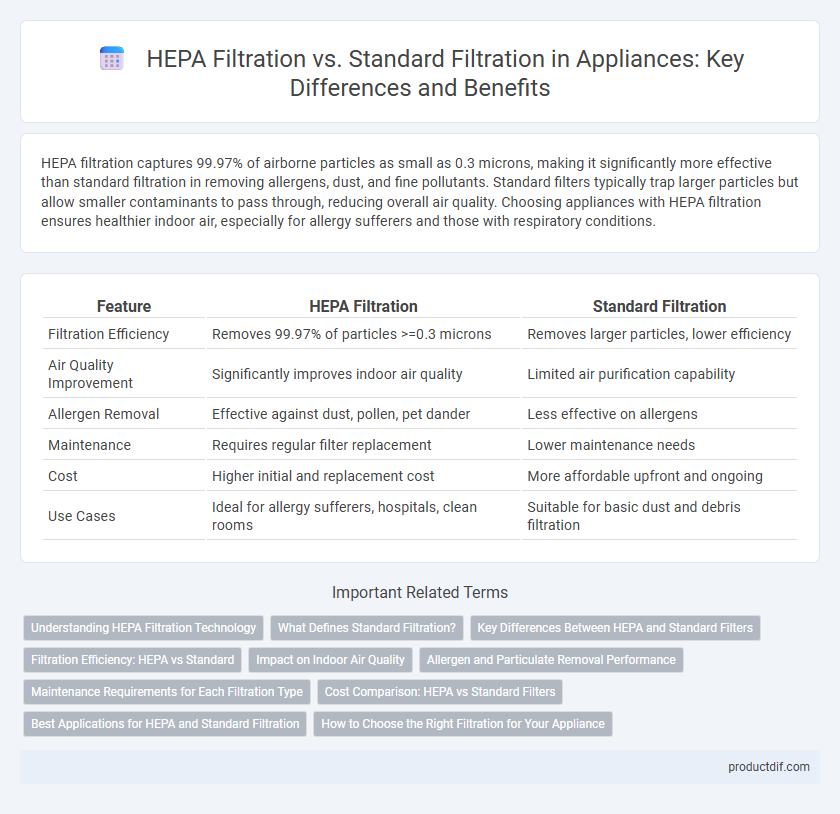HEPA filtration captures 99.97% of airborne particles as small as 0.3 microns, making it significantly more effective than standard filtration in removing allergens, dust, and fine pollutants. Standard filters typically trap larger particles but allow smaller contaminants to pass through, reducing overall air quality. Choosing appliances with HEPA filtration ensures healthier indoor air, especially for allergy sufferers and those with respiratory conditions.
Table of Comparison
| Feature | HEPA Filtration | Standard Filtration |
|---|---|---|
| Filtration Efficiency | Removes 99.97% of particles >=0.3 microns | Removes larger particles, lower efficiency |
| Air Quality Improvement | Significantly improves indoor air quality | Limited air purification capability |
| Allergen Removal | Effective against dust, pollen, pet dander | Less effective on allergens |
| Maintenance | Requires regular filter replacement | Lower maintenance needs |
| Cost | Higher initial and replacement cost | More affordable upfront and ongoing |
| Use Cases | Ideal for allergy sufferers, hospitals, clean rooms | Suitable for basic dust and debris filtration |
Understanding HEPA Filtration Technology
HEPA filtration technology captures 99.97% of airborne particles as small as 0.3 microns, providing superior air purification compared to standard filtration that often only traps larger dust and debris. Appliances equipped with HEPA filters improve indoor air quality by removing allergens, pet dander, pollen, and smoke, making them essential for allergy sufferers and those with respiratory conditions. Understanding the efficiency and particle retention capabilities of HEPA filters highlights their crucial role in advanced air cleaning systems.
What Defines Standard Filtration?
Standard filtration in appliances typically uses basic mesh or foam filters designed to capture larger particles such as dust and pet hair, with filtration efficiency often below 50%. These filters lack the fine mesh structure found in HEPA filters, resulting in limited removal of microscopic allergens, pollen, and airborne bacteria. Appliances with standard filtration are generally less effective in improving indoor air quality compared to HEPA filtration systems that capture 99.97% of particles as small as 0.3 microns.
Key Differences Between HEPA and Standard Filters
HEPA filtration captures up to 99.97% of particles as small as 0.3 microns, significantly outperforming standard filters that typically trap larger, visible dust and debris. HEPA filters are commonly used in appliances designed for allergy relief and improved indoor air quality, whereas standard filters primarily serve basic dust and particle removal. The dense fiber arrangement in HEPA filters ensures enhanced efficiency in trapping microscopic allergens, bacteria, and smoke compared to the more porous structure of standard filtration systems.
Filtration Efficiency: HEPA vs Standard
HEPA filtration captures 99.97% of particles as small as 0.3 microns, significantly outperforming standard filtration which typically traps only larger particles and allows finer pollutants to pass through. This high efficiency makes HEPA filters ideal for environments requiring superior air purity, such as homes with allergy sufferers or cleanrooms. Standard filters generally have lower Minimum Efficiency Reporting Value (MERV) ratings, indicating less effective filtration against microscopic contaminants.
Impact on Indoor Air Quality
HEPA filtration significantly improves indoor air quality by capturing 99.97% of particles as small as 0.3 microns, including dust, pollen, pet dander, and microscopic allergens. Standard filtration typically traps larger particles and allows finer pollutants and airborne pathogens to circulate, reducing overall effectiveness in maintaining a clean environment. Enhanced air purification from HEPA filters contributes to healthier living spaces, particularly benefiting individuals with allergies or respiratory conditions.
Allergen and Particulate Removal Performance
HEPA filtration systems capture 99.97% of particles as small as 0.3 microns, significantly reducing allergens such as pollen, pet dander, and dust mites compared to standard filtration, which typically filters larger particles and allows smaller allergens to pass through. The superior particulate removal performance of HEPA filters enhances indoor air quality, benefiting individuals with asthma and allergy sensitivities. Standard filters often require frequent replacement and provide limited protection from airborne irritants, making HEPA filters the preferred choice for effective allergen control.
Maintenance Requirements for Each Filtration Type
HEPA filtration requires regular replacement of filters, typically every 6 to 12 months, to maintain optimal performance and prevent airflow obstruction. Standard filtration often demands more frequent changes, approximately every 3 months, due to lower particle retention capacity and quicker filter clogging. Proper maintenance of HEPA systems involves periodic cleaning of pre-filters, whereas standard filters may require complete replacement without intermediate cleaning.
Cost Comparison: HEPA vs Standard Filters
HEPA filters typically incur higher upfront costs ranging from $30 to $70 per replacement compared to standard filters, which generally cost between $10 and $25. Despite the increased initial expense, HEPA filters provide superior air purification by trapping 99.97% of particles as small as 0.3 microns, potentially reducing long-term health-related costs. Standard filters, while more affordable, often require more frequent replacements and offer less effective filtration, impacting overall maintenance expenses.
Best Applications for HEPA and Standard Filtration
HEPA filtration excels in environments demanding superior air purity, such as hospitals, allergy-prone homes, and laboratories, by removing 99.97% of particles as small as 0.3 microns, including dust, pollen, and airborne pathogens. Standard filtration suits less critical settings like offices and industrial spaces, effectively capturing larger particles like dust and lint but lacking efficiency against microscopic allergens or contaminants. Choosing HEPA filters is optimal for allergy relief and contamination control, while standard filters offer cost-effective particle removal in general air quality maintenance.
How to Choose the Right Filtration for Your Appliance
Choosing the right filtration for your appliance depends on your specific needs for air quality and allergen control. HEPA filtration captures at least 99.97% of particles as small as 0.3 microns, making it ideal for households with allergy sufferers or asthma patients. Standard filtration provides basic dust and debris removal but lacks the advanced particle capture efficiency found in HEPA filters, making it suitable for general use where high-level purification is not critical.
HEPA Filtration vs Standard Filtration Infographic

 productdif.com
productdif.com